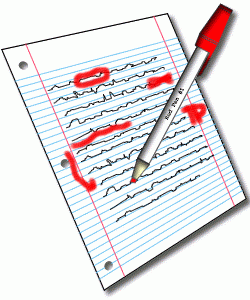Edits. Those things where someone who is not the author gets to mark up the manuscript with red pen, er, track changes. (Sometimes those are also red.) Depending on the length of story and the purpose of publication (and the publisher) the process can vary wildly. But there is a hierarchy and a purpose to each step and type of edit.
Sometimes an author gets to see them all (poor author) and sometimes parts of the process are folded together. A quick rundown of what you may encounter in your visit to the edit chamber:
Developmental or content edits:
Your primary editor, who acts as the prime minister or president of your edits, tackles these, whether you have one assigned by the publisher or a freelance editor. This is the big stuff, the stuff that may put you in rewrite conniptions. The content editor will look at your plot arc, character consistency, scene flow, pacing, plot holes and Steven Moffat style hand-waving. (Maybe not so much that last one, but I’m still mad at him.) Content editors strive not to change your story but to make it the best, shiniest story it can be.
Be nice to your content editor. They have to put up with a lot of crap from authors. Throw a tantrum in private but come back after careful consideration.
Line Edits:
(Quick note: traditionally, line edits and proofing would be separate but with many modern e-publishers, the tasks of the traditional line editor will fall to your content editor.)
A line edit is meant to catch all the nitty gritty bits that your content editor may not have caught. This should never be a major rewrite phase, but should instead catch things like word choice errors, spelling, punctuation, continuity errors, (weren’t his eyes blue?) repetitive word choices and so on. Sometimes your content editor will also do this phase as part of the content edits. With a publisher, more often this is a second person who makes suggestions, all of which are subject to approval or veto by your primary editor in cases of disagreement.
In cases where suggestions would truly change the meaning of a sentence, by all means bring it up. In small cases of grammar, though, generally the house wins. Don’t sweat the small stuff, even if your last editor said one thing about commas and this one says another.
Proofing:
The author’s last line of defense, parliamentary chamber security, if you will. The proofer makes a last pass through looking for errors, consistency within the document, (Did you say homeworld five times and home world twice? Which is it?) and making sure the document follows the house style guide.
Galleys:
This one’s all you, author! A galley is a copy of the manuscript after all the edits. You, the author, are now responsible for checking the manuscript for leftover errors. Different houses have different ways of identifying where errors are (page and line number, partial copy and paste of error and corrected phrases) so make sure to follow the instructions. In the end, it’s your manuscript and it’s your responsibility to make sure it’s clean.
Above all, be professional, be polite, let the small stuff go, and remember this is your manuscript. If it goes out with typos, your editors are human and can’t catch everything. It’s all on you.




“Chuckle!” Isaac Asimov, no stranger to editing, once wrote a story called “Galley Slave.”
Actually, line editing is supposed to focus on the “art” aspect of writing more than the technical side, which is the job of the copy editor. A line editor has traditionally focused on making the prose read compellingly, for example by suggesting rewording of clunky or dull passages, elimination of clichés, and ways to streamline action scenes.
A copy editor looks for outright errors, but also is responsible for making sure the manuscript is consistent with the publisher’s house style. If the publisher uses Oxford commas, the copy editor makes sure they’re there; if the publisher disdains Oxford commas, the copy editor eliminates them. If there are two or three generally accepted ways to spell a word, the copy editor makes the spelling consistent with the publisher’s preferred dictionary and style guide. (They’re the ones who know why it should sometimes be “copy editor” and other times “copy-editor,” even though neither look like the verb “copyedit.”) In addition, copy editors will keep an eye out for anything the line editor may have missed in terms of hair changing colors or run-on sentences. But the majority of the work is technical.
Many houses combine line-editor functions with content-editor functions and/or with copy-editor functions, which is why things get muddled.
(Disclosure: I do all these levels of editing for my work, but take on only one or two roles for large manuscripts. It’s pointless to copyedit a manuscript at the developmental stage, when much is yet to be rewritten.)